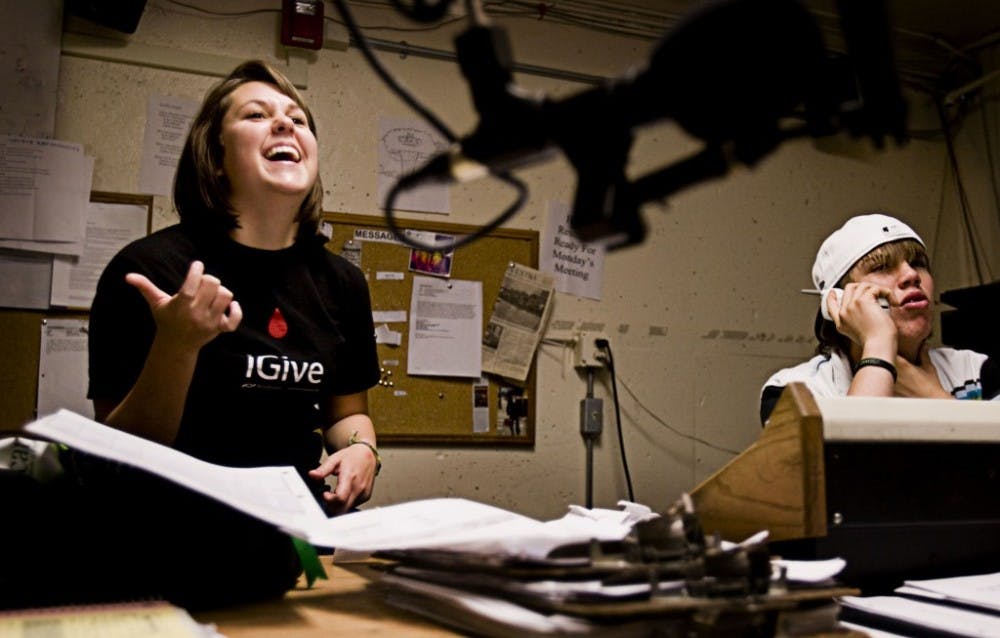At my internship this summer, I’ve moved from doing the majority of my journalistic writing with a newspaper mentality to a radio mentality. I’m interning at WCHL, a radio station and increasingly multi-platform news organization in Chapel Hill that focuses on local news around the area. That’s your Chapel Hill, your Carrboro, your Hillsborough, et cetera. And making this transition makes the differences in the two journalistic styles more readily apparent.
A good thesis for this blog post would be that newspaper is the opposite of radio, but that’s obviously not true. The opposite of radio is probably painting or eating very soft fruit. But there are still important contrasts in radio and newspaper writing that have actually helped me become a better writer in both. Ideally, this can help you too, but if you find my concepts difficult to visualize, you’ve always got the great radio resource of Elon’s own WSOE 89.3 to try out.
 The most obvious difference between writing for The Pendulum and writing for WCHL is that writing is not the end goal. Once a written story for the newspaper is completed, that’s it. Of course, there is still additional work to frame it within the page and you can include images as a part of that framing, but this is all to accommodate the product: the writing. In radio, the physical writing is the tenderizing and cooking of the ox tongue for the eventual tortino di riso alla valdostana that will be your broadcast.
The most obvious difference between writing for The Pendulum and writing for WCHL is that writing is not the end goal. Once a written story for the newspaper is completed, that’s it. Of course, there is still additional work to frame it within the page and you can include images as a part of that framing, but this is all to accommodate the product: the writing. In radio, the physical writing is the tenderizing and cooking of the ox tongue for the eventual tortino di riso alla valdostana that will be your broadcast.
With radio, you don’t just write down your quotes. You have to bring them to your listeners. And that live aspect means the entire structure and presentation of the writing itself has to be written to best smooth out the disruption playing live quotes will cause. In fact, the goal is to make sure that there is no disruption. With newspaper writing, quotes are used more to carry the story along. Well, obviously in both cases, quotes should be used to give the readers more information and support information with those in the best position to comment, but I’m talking about journalistic writing in an aesthetic sense.
Now, if you want to hear about the difference in radio and newspaper writing from an informative point of view, well boy howdy hold onto your seats because there is a lot of that. In newspaper writing, it’s always a good idea to not use too many numbers. But do you know what people hate worse than reading numbers? Hearing numbers. This means you need to be more creative in how you explain concepts over the radio so you don’t bore your listeners. In newspapers, you can get around this by using charts and graphs, but with radio, no such luck.
One big advantage that radio does have, however, is that you can give listeners a burst of activity that you can’t effectively do in newspaper. Obviously, if there’s a news event that involves some big noisy thing happening, only radio can tackle that. But sometimes, in the course of recording an interview or a meeting or something where more than one person is talking, there can be a quick back and forth or similar exchange that can illustrate a moment of realness that standalone quotes can’t. And if you’re writing a newspaper story, it’s rare to see a “this person said, then this person responded” series of quotes, let alone one that goes on for longer than two lines. For one thing, that’s a lot of paragraph breaks and a lot of newspaper space, but it also just looks… un-newspapery. But if you have that exchange recorded, you can pop it into your story with no problem. And there is a strange sort of learning an audience does from hearing, say, members of a pretty important governmental board exchange comebacks in an official meeting.
Of course, WCHL is not only a radio station. It actually focuses quite heavily on its online component, which not only includes online, all-text versions of many of the same news stories one would also create for on-air, but there are online-only stories as well. Many of these stories look more like typical pieces of written journalism, but there is still a difference in the way they are constructed and thought about. For one, they still have the present tense that the on-air stories would have, but more importantly, there is sense of immediacy that newspapers are starting to approach, but it is far more a part of the radio environment.
Recognizing the difference between the two has helped me get better at writing for both media. For the radio, knowing my limits as far as audio-only presentation helps me focus on what linguistic tools I can use. The interruptions the quotes create can be used to better organize the structure and flow of the story itself. For newspaper writing, I have a better idea of what I can express with infographics and images because radio deprived me of it. I can also see quotes as more natural parts of the writing and construct the story accordingly.
Of course, all of this says nothing about reporting itself and having the guts and know-how to get interviews and think up stories. That’s the one thing that can’t really be taught in journalism, it seems. But my time at WCHL is helping me figure out how to be a potentially professional journalist.


